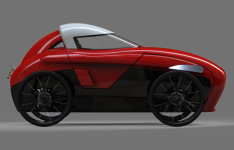Why would it be cheaper than similarly sized existing motorcycles? It has more complicated steering, it needs the gyroscopes, and the outer cladding/body.
Being produced in a much greater volume to recoup the costs of engineering, factory space and tools is one way they could be cheaper than existing motorcycles. Mass produced cars have much thinner profit margins than motorcycles, but motorcycles use much less parts/materials than their sales price would suggest when compared with a car. Due to relatively low production volume when compared to most cars, motorcycles require fatter margins than most cars to be economically viable to sell at a profit. This is because motorcycles are of extremely limited appeal to the general population which limits the size of their market niche. You get wet in the rain, cold in the winter, and are at the mercy of other drivers for collision safety. Many motorcycles in the $10,000-20,000 range could be much closer to $5,000 if they saw a 10-fold increase in production, nd sometimes do get to that price point. And there are motorcycles that sell for well under $5,000.
An enclosed vehicle has a lot more going for it from the standpoint of practicality, comfort, and safety for any casual vehicle user than a motorcycle. This is why cars greatly outsell motorcycle. By these metrics of practicality, comfort, and safety, the C-1 is more akin to "car" than "motorcycle".
Yet at an MSRP approaching $50k, the average new car sold in the USA is an increasingly unsustainable value proposition. That paradigm is going to break at some point, causing lots of overdue misery and hardship to pile onto what is already there. Getting ahead of that curve is something worth doing. Yet for most people, cars are the best value proposition available, in spite of their cost. People mostly buy used cars instead of new cars as a way to get better value for their money.
If the price of purchase and operation for a vehicle like the C-1 is more "motorcycle" than "used car", it offers a unique and useful value proposition for people who are financially struggling and need to stretch their money. There is a lot of appeal in that. The practicality and comfort of a car(except built for one person, which most cars only have one person in them at any given time), but the cost of a motorcycle. That will make a lot of sense to a lot of people.
But at $32,000, the C-1 does not offer that sort of value proposition. It's a novelty for the upper-middle-class on up. The average used car sells for $29,000 in the USA. But the C1 is a great functioning proof of concept none the less. They probably spent a crapload of money designing it and are limited in how many they can produce due to their available tools/talent/space. Which in turn keeps per unit cost high, and potential sales volume low.
A good value proposition is why people buy used cars. They are on the market at an accessible price, but that is only so for a decreasing percentage of the US population. Note the average used car is almost as expensive as the C-1 to purchase, but unlike the C-1, that used car can seat 5 or more. The cost issue isn't just the high cost of a good running car, regardless of whether it's an expensive new car or a cheap used car, but the cost of operating it. Fuel, taxes, insurance, maintenance, all add up, and many working people cannot afford to keep a car and/or use it, even if someone gave it to them for free. Yet they need transportation.
They will find a way, but that usually means a bus system that is unreliable and costs them hours each day, if that's available at all where they live.
I think the possibility for a streamlined, low-profile, LWB-recumbent-bike sized version of this C-1 exists, which could offer a very similar functionality to a car, and for greatly cheaper materials costs and even less operating expense. An electric one, ala Cedric Lynch, would be the best value proposition possible, IMO:
Add this balancing technology and landing gear from the C-1 to it, but give it the aerodynamic streamlining of a Peregrin on a Birk:
...but with a bit more ground clearance and wheels/tires/suspension/steering/comfort akin to the C-1, and AC/heating/wipers/defrost like a car.
There are decently fast motorcycles in the $5,000 range, and an enclosed vehicle with similar material use and mass could cost something akin to such a fast motorcycle. Except with attention to design, this vehicle would end up much lighter and faster than said motorcycle without being appreciably more expensive to construct and ultimately purchase, but with greatly less expense required to own and operate thanks to efficiency improvements, while offering comfort more akin to that of a car. It would even be possible to make an elongated version capable of seating two.
For viability, it all comes down to production volume... as that drives down cost.











